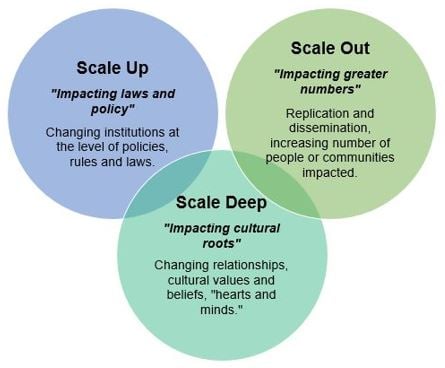Scaling Out, Scaling Up, Scaling Deep is a new paper by Darcy Riddell and Michele-Lee Moore that dives deeply into an a key question that is top-of-mind for many community change agents and funders: How do we scale up the impact of a promising social innovation? The impetus for this report, jointly commissioned by the J.W. McConnell Family Foundation and the Tamarack Institute, grew from the realization that highly successful local projects too often fail to demonstrate meaningful impact on the broader social and/or environmental systems they are operating within.
The insights documented in Scaling Out, Scaling Up, Scaling Deep were drawn from a unique cohort of individuals known as the Applied Dissemination Learning Group. This small network of social innovators developed trusting relationships with one another through the shared opportunity to learn together over time. The authors note that the experience of this group, and the support and insights they offered one another, enabled them all to become more effective than they would have been working alone. This shared peer learning experience highlights another important dimension of the work of social innovation: that “collaborative learning is an essential part of the entire social innovation process.”
Applied Dissemination Learning Group. This small network of social innovators developed trusting relationships with one another through the shared opportunity to learn together over time. The authors note that the experience of this group, and the support and insights they offered one another, enabled them all to become more effective than they would have been working alone. This shared peer learning experience highlights another important dimension of the work of social innovation: that “collaborative learning is an essential part of the entire social innovation process.”
3 Pathways for Scaling a Social Innovation
In the field of social innovation, having a good idea that demonstrates promising results in addressing a complex social and/or ecological problem is only half of the challenge. The other half of the equation is determining how best to grow or spread the use of this good idea so that it can have greater impact. Scale is the term used to describe this second dimension of social innovation work. It is the work that focuses on the best ways to expand and accelerate the use of a promising new solution so that it has greater impact.
Promising Strategies for Achieving Scale
Moore and Riddell note that the work of scaling social innovations to effect larger scale change in social and/or environmental systems is “a more complex and diverse process than simply ‘diffusing’ or spreading a product or model.” Their research with the Applied Dissemination Group identifies three primary pathways to translate promising new approaches into efforts that result in meaningful change within systems. The three pathways for scaling are:
- Scaling Out– This pathway emphasizes the replicating of successful initiatives in different jurisdictions in the hope that the initiative’s promising results can be spread to impact a growing number of people or communities. While this pathway can be effective in the short-term, it often fails to “address the deeper systems holding social problems in place.”
- Scaling Up– This pathway emphasizes changing the rules, policies and laws of institutions. Its focus is on “changing the rules of the game” to create a more enabling environment that make the old way of doing things more difficult and/or make it easier for new innovative approaches to thrive.
- Scaling Deep– This pathway recognizes that durable, lasting change is only possible when people’s beliefs – their hearts and minds -- have been transformed and the quality of their relationships to one another and the issue are viewed in new ways. The focus of this pathway is on shifting culture.
Beyond the identification of these three pathways, a key lesson learned from practitioners who focused on scaling their social innovation for systems impact emphasized the importance of explicitly acknowledging this shift in focus as it often required them, and their organizations, to clarify and or reframe their original purpose. This reframing of purpose typically included: 1) clearly articulating their shift in focus to emphasize the scaling their promising idea for greater impact; and, 2) Using systems thinking to examine – and affect – the root causes underling their innovation.
As the social innovator’s work shifted from implementation to scaling their promising idea, common challenges that were experienced included: an increased stress on leaders; and, the need to effectively manage organizational dynamics that accompanied the shift in purpose from implementing a promising innovation to scaling it up.
Specific strategies were employed to implement the various scaling pathways however which strategies were most effective, and how they unfolded, varied considerably depending on the pathway chosen as well as the unique context, assets and resources available in any particular situation. Generally four sets of strategies were identified as effective in scaling up promising social innovations. These strategies are:
- Strategies in the “Scaling Out” Pathway– Strategies used in this pathway emphasize the dissemination of principles for implanting the innovation while allowing for local adaptation and supporting the early adopters to improve their effectiveness by sharing, and co-generating, their knowledge with one another.
- Strategies in the “Scaling Up” Pathway– Strategies used in this pathway emphasize changing policies, laws and funding flows by: developing new policies and/or laws; and advocacy for new funding flows and/or the redirection of existing system resources.
- Strategies in the “Scaling Deep” Pathway– Strategies in this pathway include an emphasis on spreading big cultural ideas via the sharing of transformative stories; and an emphasis on learning and reframing; and, the establishment of Communities of Practice to support the translation of new beliefs into practice.
- Cross-Cutting Strategies– These strategies were used effectively regardless of the pathway for scaling a social innovation. They include: analyzing root causes, building networks and partnerships; seeking new resources; and, committing to regular evaluation and learning.
The pathways and strategies summarized in Scaling Out, Scaling Up, Scaling Deep offer an important contribution to our evolving understanding of how to leverage promising social innovations for greater system impact. These insights emphasize that scaling involves a far richer and more multi-faceted appreciation of dynamics than was originally understood. This report also recognizes that, while investing in learning and the infrastructure to facilitate peer learning is resource intensive, it plays an essential role in effectively undertaking the work required to scale promising social innovations to a level where they can affect systems change.





